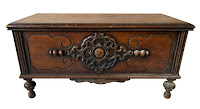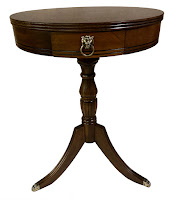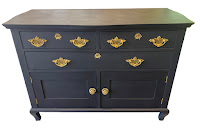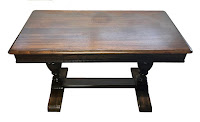 |
| Chair After |
 |
| Chair Before |
A set of four chairs that very much looked like they'd be at home in a 19th Century English Tavern, had been neglected for a long time and needed life breathed back into them. This photo shows the worst of the four, since it looked like it had been left out in the weather. It was in pretty rough shape.
The original seat and back were black vinyl, with upholstery tacks surrounding the seat area and sides of the top. The seats were torn and the foam was destroyed. Time to renew.
There was a lovely medallion carving in the center of the back, which was almost invisible prior to refinishing. Made of solid (and I mean SOLID) oak, these chairs must have weighed 40 lbs. each. This made the refinishing and reupholstery project tough, because of how many times needed to move the chairs to complete the work.
To save time, Jim removed the black vinyl and got to work. He opted to take them apart so he could access the areas that needed to be re-glued and repaired and that's the best and proper way to do it. Apart, he sanded the pieces down to bare wood then stained them with English Chestnut stain. Once the new stain was applied, the chairs were put together and "brought back to life." The final step was sprayed the polyurethane, and wow! The chairs were beautiful and that beautiful flower medallion just popped!
Once he was done working his magic, it was time for me to work mine. The chairs needed new fabric. My customer and I agreed gray would be a nice color. The old padding was not usable, so each chair got new foam and batting on the seats. As I stated before, these chairs were HEAVY! Since adding material requires a lot of moving the chair around, it was necessary to lift them up to put on my work table then down again on the floor for stapling and then up on the table again to continue other parts. You get the picture.
The curved back portion of the chair was trickier than it first looked, because each chair needed a template which I had to create from the chair's measurements instead of using the old material, since it was so distorted and badly damaged it was unusable. Upholstery has many challenges, one being sometimes you simply do not know what is involved until you get into it. Such was the case with the backs. Once I figured out that part, measuring the material properly was crucial, because if the measurement was incorrect, it wouldn't fit.
I created templates out of card stock, which gave me the precise size of each fabric section. I had to line up the top edges of the curved portion of the top prior to stitching, so that once it was pulled into position, it would fit snugly to the bottom edge before I could attach the underside with staples. This required a lot of lifting, turning, more lifting, more turning, etc. Good body mechanics is essential when doing this heavy lifting.
The last step in the process was adding the double welt cord around the seat to finish it off with a polished, professional look. I used hot glue on the double welt cord, as it is the most effective way to attach welt cord, but I also like to reinforce welt cord with tiny nails to make sure it doesn't move over time. Needless to say I was extremely happy to finish these heavy, but lovely, tavern chairs.


















































